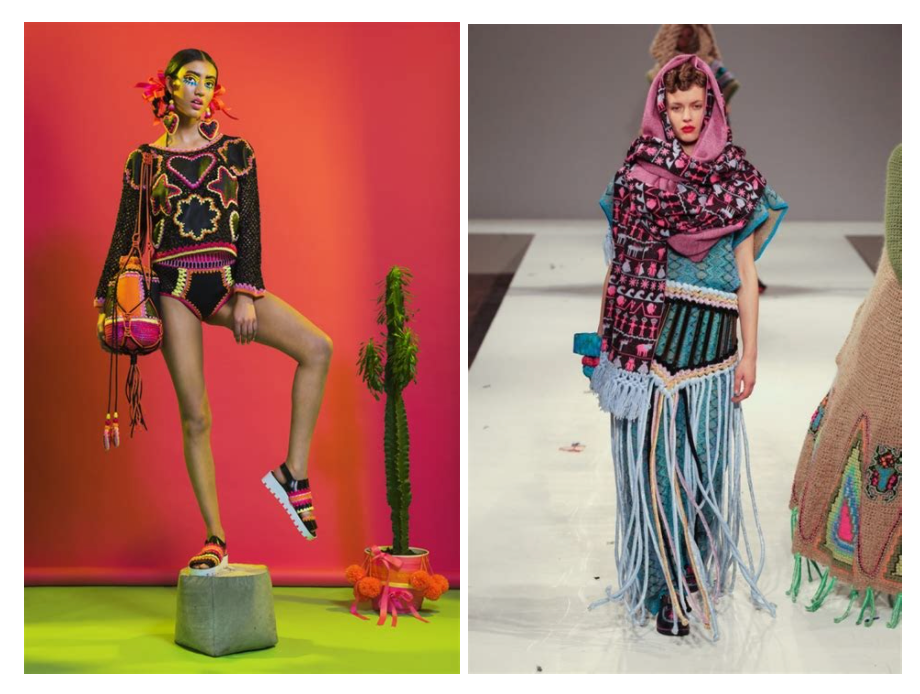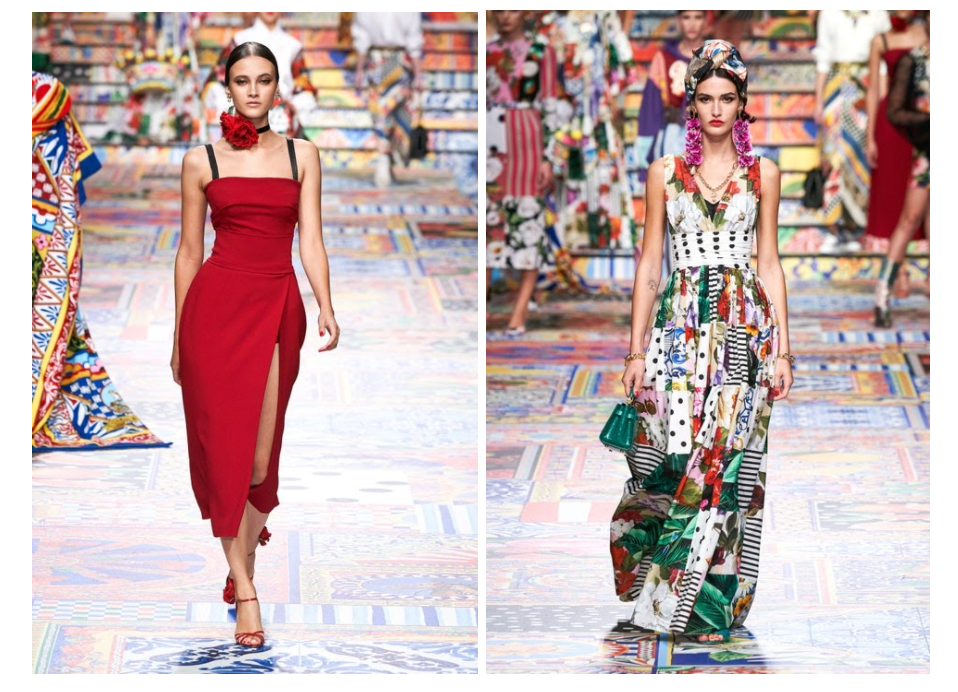Looking For Sustainability in High Fashion
- voicesofgenz

- May 12, 2021
- 5 min read
By Talia Chen

Image via Stella McCartney.
Fast fashion has recently become a mainstream concern, causing many people to reevaluate their role in consumerism and look for more sustainable and ethical places to shop. However, as Miranda Priestly (Meryl Streep) famously explained in ‘The Devil Wears Prada’, a trend had to be connected to the designers at the top of the food chain who set the pace, before it “filtered down through the department stores and then trickled on down into some tragic Casual Corner where you, no doubt, fished it out of some clearance bin.” In the traditionally most elaborate sector of the fashion industry, designers and their brands often set the scene for the whims of each season. But for this growing issue, high-end brands appear to be the ones behind. It makes sense; an industry as creative and precise as runway fashion would obviously be prone to unnecessary waste. That’s not meant to discredit runway fashion, it is, in essence, a form of art and expression, but the luxury brands have a problem to face. In what ways have they been adapting to the necessary standards of eco-consciousness while retaining the extravagance of their craft? Similarly, are they actually making changes or are they resorting to greenwashing?
So first let’s look at individual designers and how they are approaching the concept of sustainability (including pictures of their work, of course):
We’re starting off with Stella McCartney, a renowned designer who was one of the first to advocate for the environment in the high fashion industry. She has catered to a lot of celebrities, including Rihanna, Beyonce, and Kate Hudson, and is well known for weaving sustainability into her work. She uses recycled cloth and ethically sourced materials and doesn’t use real fur or leather. All of her UK stores, offices, and operations are fueled by renewable energy. Some more specific examples of her work include a line of eyewear made with castor oil seeds and citric acid, compostable shoe soles, and a lingerie line built on recycled metal and organic cotton. The magnitude of this woman’s career and her constant pursuit for a less wasteful world of fashion is very impressive.

Images via Vogue and What Do I Wear.
Then we have Mara Hoffman, who has won multiple awards for her leadership in the sustainability movement (not that awards are always the way to honor such achievements). She emphasizes slow fashion, the practice of holding onto clothing by recycling and re-wearing it instead of going through clothes at a fast pace. Her pieces tend to be vintage or handmade, with a focus on recreation. She uses hemp, organic cotton, and refibra as her main textiles and creates prints digitally to avoid unnecessary use of water.

Images via Vogue.
Next is Hillary Taymour, the designer behind the luxury brand Collins Strada. Her techniques include the use of deadstock material, upcycling, and fabric made from rose petals. Taymour is a famed Vogue Fashion Fund Finalist, i.e. she has been recognized as an up-and-coming talent. The rose petal fabric is printed and hand dyed to make a silk-like material. She gets her deadstock fabric by working with a program in Ghana that collects clothing waste and using said waste as a fabric supply.

Images via Vogue.
And then we have Katie Jones, known for her knitting and crocheting abilities. She uses upcycled leather and denim and reuses textiles. Her array of talents also includes hand embroidery and hand-dying clothes.

Images via Eco Fashion Talk and Crochet Concupiscence
Next up is Spencer Phipps, a former Dries Van Noten menswear designer who now runs the PHIPPS brand. The brand uses fabric such as organic cotton from highly specialized mills and recycled nylon. Some of their fabrics are also partially made up of hemp. He values traditional ways of making fabric, as well as slow fashion, vintage clothes, etc. Like several other designers, he refrains from creating new pieces and reuses old textiles instead.

Images via Vogue.
Lastly, we have Maggie Hewitt of the Maggie Marilyn brand, who uses bags made from cassava root in her packaging. Like the other designers featured in this article, Hewitt has worked with celebrities such as Kylie Jenner and the Duchess of Sussex. The brand is moving towards biodegradable clothing and already creates fully biodegradable bags. They value transparency and are working towards carbon neutrality. Hewitt also uses organic cotton and organic merino wool.

Images via Vogue and Vogue Australia.
There are also certain runways specifically for sustainable collections and environmental/fashion awards in different fashion hubs around the world. For example, the Green Carpet Fashion Awards in Milan Fashion Week was established in 2017. Although the luxury fashion world still has a long way to go, the rise of this environmental sector of runway fashion shows that there is potential for change. The next generation of high-end designers has already shown themselves to be much more sustainably conscious than most of their predecessors. Now let’s look at what some high-end brands are up to!
Quick disclaimer: Almost every brand of clothing has supposedly adopted some form of sustainability but a lot of them are probably just greenwashing. While the following brands aren’t the most sustainable they are taking more initiative than the typical luxury label.
I was most impressed by Chanel. They have a whole set of goals, including changing their supply chain, and they recently partnered with the University of Cambridge’s Institute of Sustainability Leadership to accurately devise practical ways to reduce carbon emissions and pollution in “specific business and societal challenges”. They will also sponsor individuals from underrepresented backgrounds so that they can attend the CISL program. Aside from that Chanel has been enthusiastically investing in companies that are working on sustainable alternatives to materials like exotic animal furs and polluting materials.
Dolce and Gabbana aren’t even close to that level of investment, but I figured we could include them for the sake of showing what most brands are doing: dedicating shows to the sustainability-related concepts. This is also a great way to advocate for the environment through creativity, but big brands like Yves Saint Laurent and Dolce and Gabbana could definitely be doing more. Dolce and Gabbana created a collection centered around recycling/reusing old designs for their Spring Season 2021 collection, in which they incorporated fabrics from different European cultures to highlight the concept of resourcefulness.

Images via Vogue.
Versace, Jimmy Choo, and Michael Kors are all owned by Capri Holdings, a global luxury group that is now a part of the United Nations Global Impact, the largest corporate sustainability initiative in the world. The group plans to concentrate on material sourcing, emissions, water usage, and reducing waste.
Gucci also did a collection dedicated to sustainability, but they intend to implement a circular model of production in which materials can be recycled back into the process. Unlike Dolce and Gabbana’s show, Gucci’s Off the Grid collection is all sustainably sourced, recycled, or bio-based. They even change their packaging to FSC-certified recycled cardboard and a recyclable nylon dust bag. This indicates a higher level of commitment to sustainability than brands like Dolce and Gabbana because they put in the work to make everything environmentally friendly as well. So of course, here are some pieces from Off the Grid.


Images via Gucci Equilibrium.
All in all, these high-end brands and designers are catching on; they just need to be held accountable so that they actually make changes for the better of the planet. Some are definitely being much more proactive than others, and no doubt there are plenty of brands that are resorting to greenwashing but hopefully, they soon realize how necessary sustainability is in an industry as fast-paced and extravagant as high fashion.
Written by writer Talia Chen.







Comments